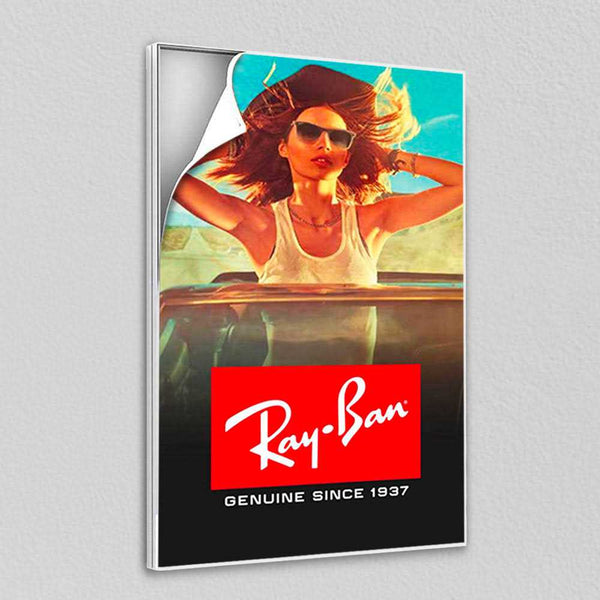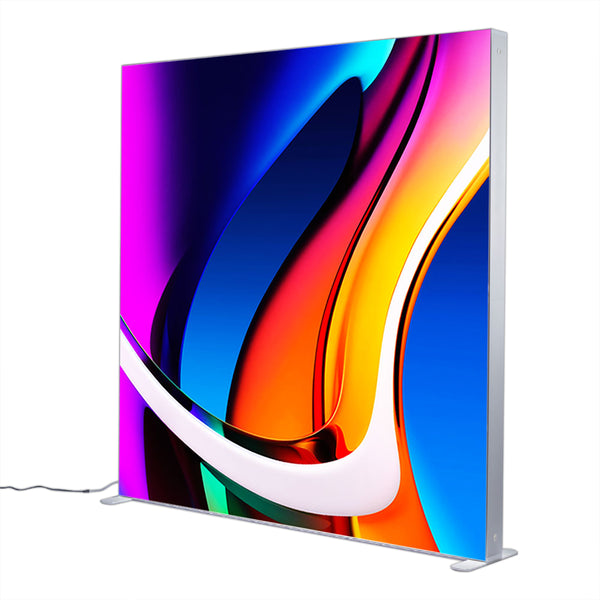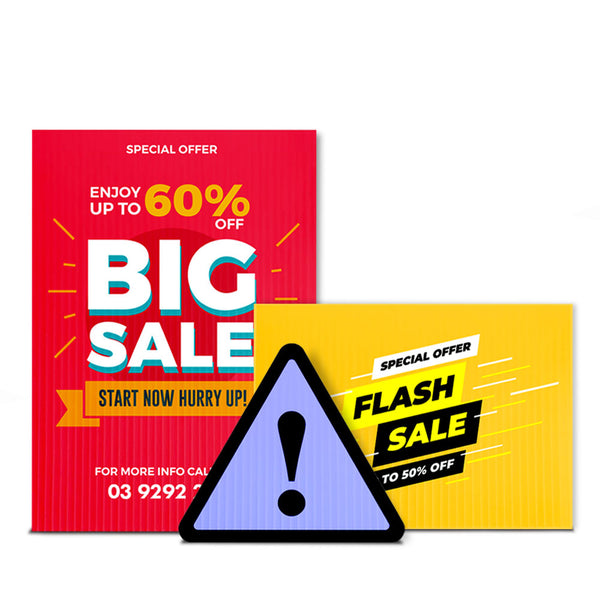The Ultimate Guide to Different Types of Signage.

Have you ever decided to walk into a restaurant just because you were inspired by its enticing outdoor signage? That’s how effective signage is; it controls the minds of potential customers.
When it comes to building brand awareness, establishing a brand personality, and improving brand recall, nothing proves more valuable than effective signage. However, choosing from the never-ending list of signs is not easy. Each sign has its own unique purpose and helps achieve specific business goals. Learn more in our article, Why You Should Invest in Your Business’s Signage.
Therefore, it’s important to keep your goals in mind when making an investment. In this guide, we’ll take you through the different types of signage options available. But before we get into that, let’s examine the purpose of signage and what counts as effective signage.
What Is the Purpose of Signage?
Improves Brand Exposure
As the most visible form of communication for brands, signage can greatly impact the performance of your brick-and-mortar store. The attractiveness and quality of your signs shape the assumptions customers make about your business, which in turn impacts how customers perceive your products or services.
Brand exposure is further enhanced when you complement outdoor signage with wayfinding design. This not only leads to new customer acquisition but also results in repeat business.
Likewise, poor quality signage often proves to be a big turn off for customers who are then less likely to engage with your business or make a return purchase.
Stand Out from the Competition
Effective signage helps your business get a competitive advantage over competitors. A creative, well-designed storefront sign serves as a differentiator between you and other businesses, drawing the attention of customers from a distance
Where you choose to install your signs also plays a role in giving you a competitive edge in the market. Placing your wayfinding signs, for instance, at a high traffic point close to your store should allow potential buyers to quickly discover your brand’s physical presence.
Improves Brand Recognition
Your ability to affect attitudes and perceptions depends on your brand recognition. This establishes a strong connection with your target audience, generating more repeat business and increased market share.
The simplest example is that of Starbucks, which uses signage to its full potential. Because of their signs, everyone recognizes the Starbucks logo.
What Is Effective Signage?

It’s important for marketers to understand that not every sign will make the desired impact. You need effective signs to catch people’s attention and direct them to your store. If you want effective signs, you need to consider a few factors.
One of the most important factors to consider is visibility. Signs carrying short messages are easy to see and read at a glance. Think about the distance you expect your signs to be seen from and choose the size and shape of the signage accordingly. Depending on where you install the signs, don’t forget to account for any obstructions that might come in the way.
Also, some marketers limit the message but fail to communicate it in a concise manner. This results in clutter. The more words and lines you add to your signage, the tougher it will be for your customers to read it from a distance.
Use as few words as possible to convey your message to your target audience. Keep in mind that the empty space on your signage is just as important as the filled space on your sign. To ensure readability, leave 30% to 40% of the sign’s surface empty..
Also, the most legible signs tend to be the most effective signage. Use crisp and clean font styles that are clearly legible when read from a distance. Highlight the most important parts of your message using black, bold, and extended font weights. Using two different fonts that complement each other can help your message stand out. However, don’t use more than two fonts as that can hurt readability.
Based on visual tests, using upper and lower case letters enhances readability as opposed to just using all upper case letters. Therefore, avoid overusing upper case letters.
What Are the Different Types of Signage?
Let’s now take a look at the different types of signage options available out there.
Billboards
Billboards are large-scale print banners placed in high-traffic areas, such as on roads and highways, to advertise a brand, company, campaign, product or service.
They’re used for billboard advertising, which serves to broadcast your business to as many pedestrians and drivers as possible with an aim to build brand awareness.
Since they’re normally placed in high-traffic areas, billboards tend to generate the highest number of views and impressions as compared to other advertising techniques.According to Harley’s Dream, 71% of people consciously glance at billboards while driving.
When you decide to invest in billboards so that your content is seen by millions, you’ll need to ensure that it does its job. To make your billboards eye-catching and effective, you’ll need to choose the right designs. Let’s discuss how you can design an effective billboard.
How Do You Design a Billboard?

Tell a Story
Use images and text to take the viewers on a short, 4-second journey. Since most drivers won’t read more than a few words, convey the essence of your campaign or idea using graphics.
Take a look at how the marketer uses more images than text to convey the brand story in the picture above.
Keep it Simple
Pedestrians and drivers have no more than a few seconds to get a glimpse of your billboard. Some drivers might be moving at 70mph or faster. Thus, it’s important to keep your billboard advertising simple to reach the highest number of viewers.
Use large, bold fonts against contrasting backgrounds when depicting text. Use colours that will stand out from the surroundings. For example, avoid using green, brown, and blue colours if you plan to place your billboard in a rural area so that it contrasts with the trees, mountains, and the sky.
Relate them to Its Location
Billboards that reflect the ideas associated with its location are more likely to be noticed and foster customer engagement. Brainstorm on the sports teams, nuances, inside jokes, norms, etc., related to the area and try to incorporate those ideas in your billboards to make them more impressionable.
Do Billboards Work for Advertising?
While billboards have long been an incredible marketing channel, you might be concerned whether they still work for advertising. It’s true that numerous other advertising methods have taken over the corporate world, especially digital marketing. However, the new channels and techniques have not deterred audiences from looking at billboards and relying on them to make buying decisions.
A large number of people still spend a greater proportion of their hours outdoors, such as in their cars, walking, or running, than they do reading magazines or watching TV. Through strategic billboard advertising, you can take advantage of this.
What Makes an Effective Billboard?
Following are some of the characteristics of an effective billboard:
- Targets your core audience
- Includes high-resolution and engaging Images
- Keeps the audience entertained
- Includes sufficient contact information
- Uses colours that resonate with the brand
- Are well-designed
- Highly visible and easy to read
- Includes minimal text
StandOff Signage
What Is a Sign Standoff?
A sign standoff is a small piece of hardware that’s appended to a sign to mount it onto a wall. Comprising a barrel cap and a screw, sign standoffs are available in different styles.
The most popular sign standoff is known as the ‘through-grip’ standoff. To use a through grip, your sign must have a small hole through which the barrel’s cap screws into the barrel.
Other types such as edge-grip standoffs don’t require any holes in your signage. Instead, they join at the edges of your signs.
Why Use Standoff Signs?
The primary reason to use standoff signs is the unique way it mounts your signage in place. Unlike other mounting hardware, standoffs allow your signs to stand away from the wall, producing a 3D effect around the signs. This allows businesses to make a lasting impact on clients and visitors through indoor signage.
How Do You Use Stand Off Signs?
Follow these steps to assemble sign standoffs:
- Obtain the relevant measurements from your sign and use them to mark the wall where screws need to go.
- Use a drill bit to drill pilot holes on the screw marks
- Unscrew the barrel cap in your standoff
- For all four standoffs, screw the wall screw at the bottom of the barrel and through the pilot hole
- Position your sign with the four barrels on the wall so that they are right in front of the holes
- Screw the barrel caps through the sign and into the barrels to secure the sign in place.
Vehicle Signage

What Is a Vehicle Wrap?
A vehicle wrap is a large decal or vinyl graphic. It is applied on vehicles for branding and advertising purposes. Applied directly over the original vehicle paint, vehicle wraps dramatically alter the aesthetics of your vehicle in a short time. At any point in time, you may remove the wrap to return the vehicle back to its original appearance.
Why Is Vehicle Signage Important?
Vehicle wraps are among the most effective ways of marketing a business, especially if you cater to a local audience. It allows for unlimited exposure around the town. Unlike static advertising banners, such as billboards, vehicle wraps are highly mobile marketing banners that keep on travelling to wherever your vehicles are driven, thereby increasing your company’s exposure.
Depending on how engaging your vehicle wraps are, they can be hard to miss on any busy road. The human eye is naturally attracted to something different so your branded vehicle is certainly going to be noticed among so many cars.
If you own a fleet, applying vehicle wraps should make your vehicles’ look aesthetically pleasing and professional. As more and more new people see your vehicles, you will experience a boost in brand awareness and recognition.
On top of that, while other advertising channels may be difficult to manipulate, changing your advertising content on vehicle wraps is incredibly easy. All you need to do is have the wrap removed and install a new one to change your advertising message.
How Long Do Vehicle Wraps Last?
When you invest in a particular type of signage, it certainly makes sense to ask how long it will last. The life expectancy of vehicle wraps depends on various factors, such as where the vehicle runs, the climate, exposure to sun, how often they’re washed, and so on.
The average lifespan of a vehicle wrap under normal circumstances is 5 years. If a vehicle stays out every day and is extensively used for transportation, the exposure to sun and wind will lead to more wear and tear and the wrap won’t last for more than 2 years.
Simply parking your vehicle in the shade can actually enhance the life expectancy of the vehicle wrap to 3 or 4 years. Vehicle wraps on a vehicle that’s not used much can even last for 7 years.
In a Nutshell
Signage plays a critical role in generating new leads and nurturing your existing leads through the buyer journey. Now that you are convinced about the purpose of having signage and have an in-depth idea about the most influential types of signage, it’s time to take the lead and start advertising your business through signs.
Find out more in Outdoor Vs. Indoor Advertising: Which One Is More Effective.
For highly impactful signage, get in touch with Vivid Ads today.We cater to different signage needs and have many types of signs for you to choose from!



